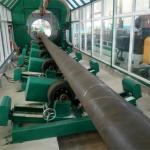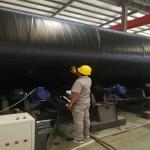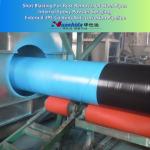2.Under the conveying of the rust removal conveyor, the steel pipe
enters the cleaning room of the outer wall shot blasting rust
removal machine after intermediate frequency preheating. When the
impeller of the shot blasting machine rotates at high speed, the
abrasive (steel shot+multi edge sand mixture) is ejected onto the
outer surface of the steel pipe under the action of large
centrifugal force. The oxide scale and rust layer on the outer
surface of the steel pipe are cleaned under the impact of abrasive
jet, achieving the surface cleanliness specified by the coating
standard. Simultaneously obtaining a certain depth of anchor
pattern to enhance the adhesion of the coating.
3.After completing the outer wall shot blasting and rust removal,
the steel pipe is transported to the lower pipe station. The
hydraulic transverse pipe transport vehicle lifts the steel pipe
off the conveyor roller and transfers it to the inner rust removal
station to blow away the residual dirt inside the pipe. Start the
internal blower and use high-pressure airflow to blow away residual
sand and dirt inside the steel pipe, followed by rust removal
quality inspection.
4. After the rust removal quality inspection of the steel pipe is
qualified, the rotating roller is started to drive the steel pipe
to rotate. According to the production plan and construction
specifications, the pipe end is pasted with masking paper.
5. After the pipe end avoidance treatment is completed, the steel
pipe is transferred through the pipe transport vehicle, straight
conveyor roller, and platform. Then, the steel pipe is transported
to the central axis of the coating spiral conveyor roller by the
pipe transport vehicle and dropped onto the conveyor roller. Under
the drive of the power wheel of the transmission roller, the steel
pipe rotates on one side and moves straight forward on the other
side. After cleaning the fine dust on the outer wall, the steel
pipe enters the coating heating medium frequency induction heating
coil and is heated to 200-220 ℃ (determined according to the
requirements of the material supplier). Turn on the epoxy powder
electrostatic spraying equipment, evenly coat the surface of the
electric steel pipe with epoxy powder, and pay attention to the
melted and gelatinized state of the powder. When the steel pipe
with good powder gelatinization enters the winding area, two single
screw extruders are turned on separately for AD winding and PE
winding. The pneumatic silicone bonding roller is operated to roll
the winding coating, and the pressure of the roller is controlled
to avoid the coating thickness at the weld seam not being less than
70%. At the same time, observe the overlap of each material strip,
measure the coating thickness of the trial production pipe, adjust
the extruder parameters at any time until the operation is stable,
and complete the continuous coating of the 3PE coating.
6. After completing the coating of the steel pipe, it immediately
enters the coating water cooling area. At this time, pay attention
to the surface morphology of the PE layer, adjust the cooling water
flow rate, flow velocity, and water pressure to avoid water induced
spots on the coating surface. Under the action of cooling water,
the surface of the anti-corrosion coating rapidly cools to below 60
℃ to a cured state, preventing damage to the coating in subsequent
processes and facilitating subsequent construction.
7. After the coating cooling of the steel pipe is completed and it
exits the cooling water shower room, the front pipe accelerates and
separates from the rear pipe in the separation area. Use a
transverse pipe transport truck to lift the steel pipe off the
conveyor roller, pass through the transfer of the pipe transport
truck, straight conveyor roller, and platform, and then be
transported to the pipe end coating groove polishing station of the
finished product outlet platform by the pipe transport truck.
| No. | Name | Set |
| A. Derusting Equipment |
| 1 | Pipe-converying Equipment | 1 |
| 2 | Shot Blast Cleaning Machine | 1 |
| 3 | Cyclone Dust Collector | 1 |
| 4 | Pulse dust collector | 1 |
| 5 | Centrifugal exhaust fan | 1 |
| 6 | Rust removal equipment PLC | 1 |
| B. Coating equipment |
| 1 | Coating transfer equipment | 1 |
| 2 | IF heating device | 1 |
| 3 | Powder spraying device | 1 |
| 4 | Automatic loading dryer | 2 |
| 5 | SJ-65/30 Extruder | 1 |
| 6 | SJ-180/30 Extruder | 1 |
| 7 | Hot melt adhesive extruder die | 1 |
| 8 | PE sheet extruder head mold | 1 |
| 9 | Hot melt adhesive/PE sheet coating device | 1 |
| 10 | Environmental Protection Ventilation equipment | 1 |
| 11 | Cooling Spray equipment | 1 |
| C.Platform Equipment |
| 1 | Steel pipe platform | 1 |
| 2 | Post-rust removal transition platform | 1 |
| 3 | Product tube storage platform | 1 |
| 4 | Hydraulic Equipment | 3 |
| D.Groove Equipment |
| 1 | PE Beveling Machine | 2 |
| 2 | Hydraulic Lifting and Turning Machinery | 1 |
| 3 | Hydraulic Equipment | 1 |
| 4 | PLC | 1 |
| E.Compressed air Equipment |
| 1 | Screw Air Compressor | 1 |
| 2 | Cold dry machine | 1 |
| 3 | Precision filters | 3 |
| 4 | Gas tanks | 1 |
The technological processes employed by Huashida Machinery for the
3LPE coating of steel pipes involve a series of meticulous steps
designed to ensure the highest level of quality and durability.
Here's a detailed overview of the process:
- Upload Pipes:
- The process begins with the loading of the steel pipes onto the
production line. This step ensures that the pipes are positioned
correctly and ready for processing.
- Pipes Screw Conveyor:
- Once loaded, the pipes are transported through the production line
using a screw conveyor. This efficient system gently moves the
pipes forward, allowing for continuous and uninterrupted
processing.
- Rust Removal via Intermediate Frequency Heating:
- To ensure a smooth and even coating, it's crucial to remove any
rust or impurities from the pipe surface. This is achieved through
intermediate frequency heating, which raises the temperature of the
pipe surface to effectively burn off rust and contaminants.
- Epoxy Powder Coating:
- Following rust removal, the pipes are coated with an epoxy powder
primer. This layer acts as a corrosion-resistant barrier, providing
a strong foundation for the subsequent coatings.
- Outer Layer Solidification & Polyethylene Coating:
- Next, the pipes undergo the application of the outer layer, which
consists of a solidified coating and a polyethylene layer. The
solidification process ensures that the coating adheres firmly to
the pipe surface, while the polyethylene layer provides additional
protection against corrosion and wear.









